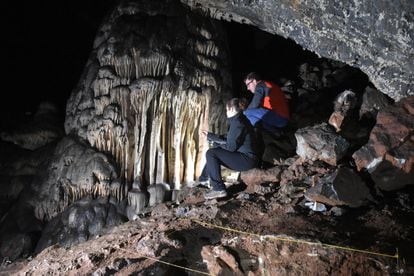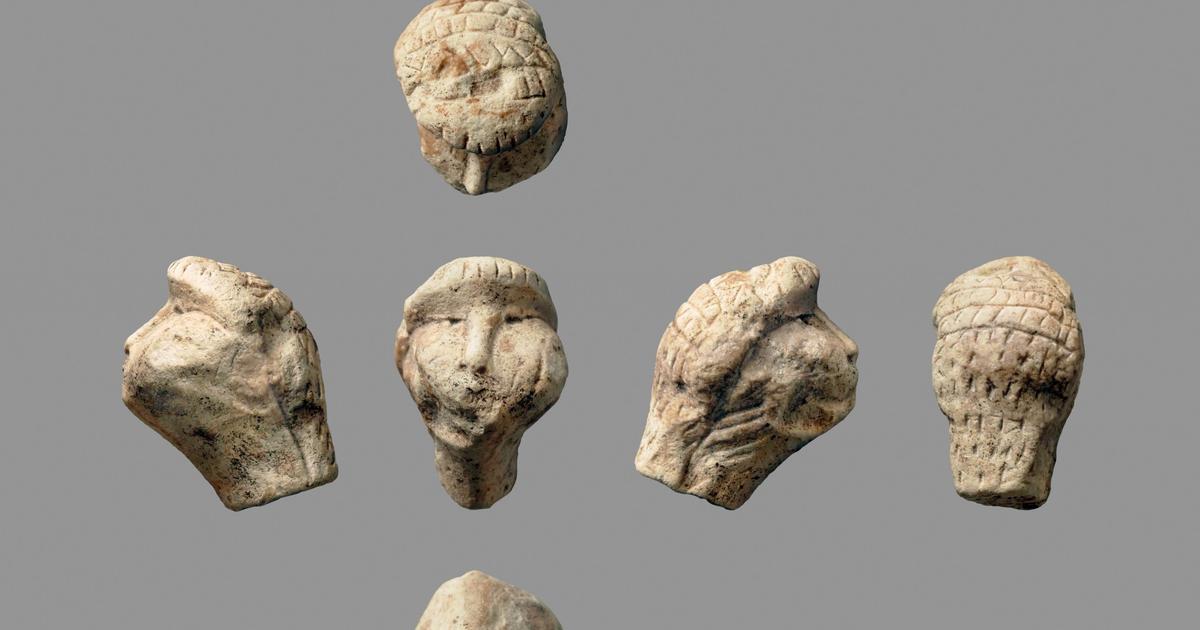The oldest rock art works were made by Neanderthals in various caves on the Iberian Peninsula.
The discovery, made in 2018, did not convince part of the scientific community, which doubted the ability of these other humans.
Now, detailed analysis on one of them confirms that they were members of this species.
Furthermore, they painted in the same place for millennia, long before the arrival of the sapiens.
If repeated in other sites, these red spots would show that
Homo neanderthalensis
already gave a special, symbolic value to certain places.
More information
Neanderthal carved symbol found 51,000 years ago
Modern science is especially critical of its recent past and its idea of progress in general and the scientist in particular. After Darwin and with positivism, during the second half of the 19th century and the first half of the 20th, the vision of the advance of history as linear and, in general, always better: the past is backward and the future progress. In the field of human evolution (the term itself lends itself to bias), the idea that
Homo erectus
they were more backward than the Neanderthals and these more brutal than the sapiens.
Although this vision is long overdue, its embers led some to question the 2018 study, arguing that more than strokes of paint they looked like spots of geological or natural origin.
They did not agree that members of this extinct species were the first to
graffiti
the walls.
However, a meticulous analysis of a series of red lines in a large stalagmite in the Ardales cave (Málaga) has confirmed that they were painted by someone since at least 64,800 years ago.
And since modern humans did not reach the Iberian Peninsula many millennia later, it must have been the Neanderthals who did.
The analyzed paintings were made about 65,000 years ago in a cave in Malaga
Located in the so-called room of the stars, this stalagmitic speleothem has several of its columns marked with ocher. Their study, the results of which have been published in the scientific journal
PNAS
, indicates that the pigment used is a type of ocher (mainly iron oxide) that does not exist anywhere else in the cave and that it must have arrived there from outside.
Researchers, among whom there are in addition to prehistorians and paleontologists, experts in crystallography and mineralogy, rule out anything other than the intentional action of humans. It is detailed by the researcher at the University of Barcelona and co-author of the study João Zilhão: "The pigment is a hematite [iron oxide mineral] that does not exist inside the cave, it was contributed by humans." Regarding the thesis of natural origin, they confirmed that it had been applied on the stone: “Not a stain of the same calcite by natural processes coevo of the precipitation of the crystals nor of accumulations resulting from biological (microorganisms) or geological activity (floods ...) ".
This confirms that these are the oldest paintings, along with those of La Pasiega (Cantabria), made in a cave by Neanderthals.
There are some stones with reddish lines that the sapiens drew in South Africa 73,000 years ago.
The great stalagmite is found in an area of the cave called the room of the stars.Pedro Cantalejo-Duarte
But there is another discovery that suggests many things to researchers. Although the oldest traces are from about 65,000 years ago, there are others on other columns of the same stalagmite that are more recent. They have confirmed another group of brands, although they believe there were at least two other pictorial forays. And all this in a range of about 20,000 years and always by Neanderthals. "Our interpretation is that the cave itself, and this dome in particular, had a symbolic significance (ritual, mythological, or other) that was marked / underlined by the act of spreading the red pigment over it," says Zilhão.
The repetition of the paintings is what stands out the most the prehistorian of the Complutense University of Madrid Marcos García Diez, who has not intervened in this study, but has investigated the Ardales cave in depth. "It implies that there has been an oral tradition passed down over millennia about the ornamental, symbolic or whatever value of the cave," he says. As in other more recent artistic expressions, it is possible that "the image has no function or meaning until it is on the site, the function is not given by the image, it is given by the place," he adds. And this, which had already been observed in sapiens, "is the first time it has been seen in Neanderthals," adds García Diez.
For Roberto Ontañón, director of the Museum of Prehistory and Archeology of Cantabria (MUPAC), this research is relevant, especially the determination of the human origin of the paintings. But it is more prudent to interpret their symbolic relevance or about who painted them. According to him, for the authors, "it would not be, therefore, art in the restricted sense of the term, but the result of graphic behaviors aimed at perpetuating the symbolic meaning of an underground space." In this way, "speleothems would play a fundamental role in the symbolic systems of some Neanderthal communities, and these manifestations would account for a behavior deeply rooted in a long-standing tradition," Ontañón completes. "
"There is still much to investigate before discarding the alternative hypothesis: that the authors were sapiens who arrived much earlier through the Strait of Gibraltar and not Neanderthals"
Roberto Ontañón, director of the Museum of Prehistory and Archeology of Cantabria
But this vision of Neanderthals runs the risk of repeating the opposite error to the one that in the past despised them as gross relatives: “In what constitutes, perhaps, an excess of sign opposed to the previous
speciesist
prejudice
, there are researchers who show an undeniable enthusiasm when it comes to equating Neanderthals and sapiens, attributing to the first capacities previously considered exclusive to our species such as graphic expression and even numerical computation ”, comments the director of MUPAC. For Montañón there is still much to investigate and discover about the details of these paintings before discarding the alternative hypothesis: that the authors were Sapiens who arrived much earlier through the Strait of Gibraltar and not Neanderthals.
* This study on the Ardales cave is part of a larger project co-directed by José Ramos Muñoz (University of Cádiz) and Gerd C. Weniger (Neanderthal Museum, Germany) financed by the Ministry of Economy, Industry and Competitiveness.
You can follow MATERIA on
,
and
, or sign up here to receive
our weekly newsletter
.



/cloudfront-eu-central-1.images.arcpublishing.com/prisa/4RITWNCKAZFB3I3MBXYYKH6YDI.jpg)




